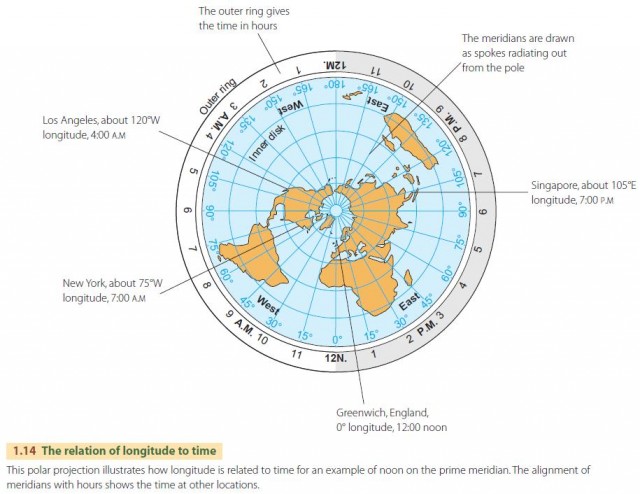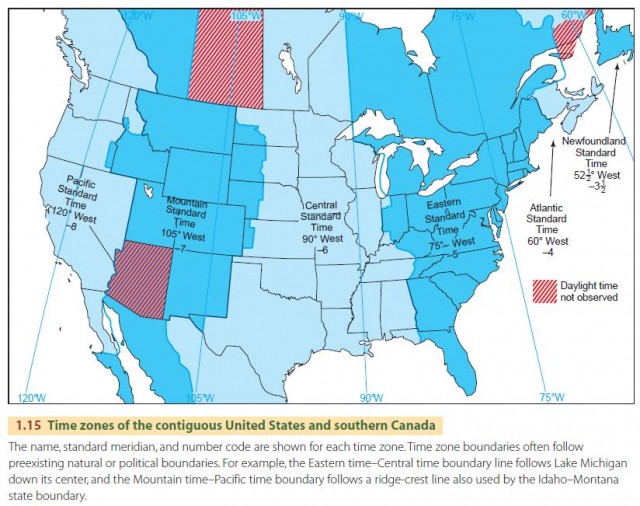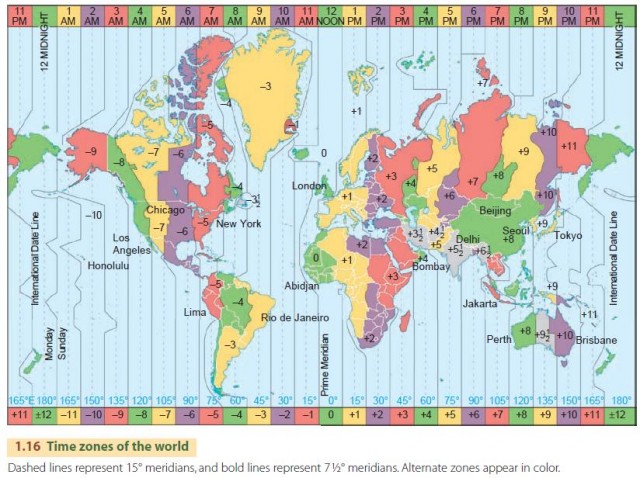Global Time
There's an old Canadian joke that goes, “Repent! The world will end at midnight! or 12:30 A.M. in Newfoundland.” It's humorous because independent-minded Newfoundlers use a time zone that is a half-hour ahead of the other Canadian maritime provinces. It highlights the fact that one single instant across the world—no matter how cataclysmic—is simultaneously labeled by different times in different local places.
Humans long ago decided to divide the solar day into 24 units, called hours, and devised clocks to keep track of hours in groups of 12. Yet, different regions set their clocks differently—when it is 10:03 A.M. in New York, it is 9:03 A.M. in Chicago, 8:03 A.M. in Denver, and 7:03 A.M. in Los Angeles. These times differ by exactly one hour. How did this system come about? How does it work?
Even in today's advanced age, our global time system is oriented to the Sun. Think for a moment about the Sun moving across the sky. In the morning, the Sun is low on the eastern horizon, and as the day progresses, it rises higher until at solar noon it reaches its highest point in the sky. If you check your watch at that moment, it will read a time somewhere near 12 o'clock (12:00 noon). After solar noon, the Sun's elevation in the sky decreases. By late afternoon, the Sun hangs low in the sky, and at sunset it rests on the western horizon.
Imagine for a moment that you are in Chicago. The time is noon, and the Sun is at or near its highest point in the sky. You call a friend in New York and ask about the position of the Sun. Your friend will say that the Sun has already passed solar noon, its highest point, and is beginning its descent down. Meanwhile, a friend in Portland will report that the Sun is still working its way up to its highest point. But a friend in Mobile, Alabama, will tell you that the time in Mobile is the same as in Chicago and that the Sun is at about solar noon. How do we explain these different observations?
The difference in time makes sense because solar noon can only occur simultaneously at places with the same longitude. Only one meridian can be directly under the Sun and experience solar noon at a given moment. Locations on meridians to the east of Chicago, like New York, have passed solar noon, and locations to the west of Chicago, like Vancouver, have not yet reached solar noon. Since Mobile and Chicago have nearly the same longitude, they experience solar noon at approximately the same time.
Figure 1.14 indicates how time varies with longitude. Since the Earth turns 360° in a 24-hour day, the rotation rate is 360°/24 = 15° per hour. So 15° of longitude equates to one hour of time.

STANDARD TIME
We've just seen that locations with different longitudes experience solar noon at different times. But what would happen if each town or city set its clocks to read 12:00 at its own local solar noon? All cities and towns on different meridians would have different local time systems. With today's instantaneous global communication, chaos would soon result.
Standard time simplifies the global timekeeping problem. In the standard time system , the globe is divided into time zones. People within a zone keep time according to a standard meridian that passes through their zone. Since the standard meridians are usually 15 degrees apart, the difference in time bet ween adjacent zones is normally one hour. In some geographic regions, however, the difference is only one-half hour.
Figure 1.15 shows the time zones observed in northern North America. The United States and its Caribbean possessions fall within seven time zones. Six zones cover Canada. Their names and standard meridians of longitude are as follows:


WORLD TIME ZONES
According to our map of the world's time zones (Figure 1.16 ), the country spanning the greatest number of time zones is Russia. From east to west, Russia spans 11 zones, but groups them into eight standard time zones. China covers five time zones but runs on a single national time using the standard meridian of Beijing.
A few countries, such as India and Iran, keep time using a meridian that is positioned midway between standard meridians, so that their clocks depart from those of their neighbors by 30 or 90 minutes. Some states or provinces within countries also keep time by 7 ?° meridians, such as the Canadian province of Newfoundland and the interior Australian states of South Australia and Northern Territory.
World time zones are often referred to by number to indicate the difference in hours between time in a zone and time in Greenwich. A number of ?7, for example, indicates that local time is seven hours behind Greenwich time, while a +3 indicates that local time is three hours ahead of Greenwich time.

INTERNATIONAL DATE LINE
Take a world map or globe with 15° meridians. Start at the Greenwich 0° meridian and count along the 15° meridians in an eastward direction. You will find that the 180th meridian is number 12 and that the time at this meridian is therefore 12 hours later than Greenwich time. Counting in a similar manner westward from the Greenwich meridian, we find that the 180th meridian is again number 12 but that the time is 12 hours earlier than Greenwich time. We seem to have a paradox. How can the same meridian be both 12 hours ahead of Greenwich time and 12 hours behind it? The answer is that each side of this meridian is experiencing a different day.
Doing the same experiment an hour later, at 1:00 A.M., stepping east you will find that you are in the early morning of June 26. But if you step west you will find that midnight of June 26 has passed, and it is now the early morning of June 27. So on the west side of the 180th meridian, it is also 1:00 A.M. but it is one day later than on the east side. For this reason, the 180th meridian serves as the international date line. This means that if you travel westward across the date line, you must advance your calendar by one day. If traveling eastward, you set your calendar back by a day.
Air travelers between North America and Asia cross the date line. For example, flying westward from Los Angeles to Sydney, Australia, you may depart on a Tuesday evening and arrive on a Thursday morning after a flight that lasts only 14 hours. On an eastward flight from Tokyo to San Francisco, you may actually arrive the day before you take off, taking the date change into account!
Actually, the international date line does not follow the 180th meridian exactly. Like many time zone boundaries, it deviates from the meridian for practical reasons. As shown in Figure 1.16 , it has a zigzag offset between Asia and North America, as well as an eastward offset in the South Pacific to keep clear of New Zealand and several island groups.
DAYLIGHT SAVING TIME
The daylight saving time system allows us to cheat standard time and transfer an hour of light to a time when it will be more useful. In our modern world, we often wake up well after sunrise and continue being active until long after sunset, especially if we live in urban areas. So we adjust our clocks during the part of the year that has a longer daylight period to correspond more closely with the modern pace of society. By setting all clocks ahead by one hour, we steal an hour from the early morning daylight period—which is theoretically wasted while schools, offices, and factories are closed—and give it to the early evening, when most people are awake and busy.
In the United States, daylight saving time comes into effect on the second Sunday in March and is discontinued on the first Sunday of November. Arizona (except the Navajo Nation), Puerto Rico, Hawaii, U.S. Virgin Islands, Guam, the Northern Mariana Islands, and American Samoa do not observe daylight saving time. Although many other nations observe daylight time, they do not always begin and end daylight time on the same days of the year. In the European Union, daylight saving time is called summer time. It begins on the last Sunday in March and ends on the last Sunday in October.
PRECISE TIMEKEEPING
Many scientific and technological applications require precise timekeeping. Today, a worldwide system of master atomic clocks measures time to better than one part in 1,000,000,000,000. However, our Earth is a much less precise timekeeper, demonstrating small changes in the angular velocity of its rotation on its axis and variations in the time it takes to complete one circuit around the Sun. As a result, constant adjustments to the timekeeping system are necessary. The legal time standard recognized by all nations is coordinated universal time , which is administered by the Bureau International de l'Heure, located near Paris.